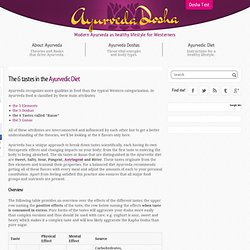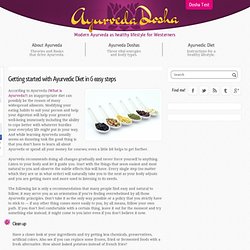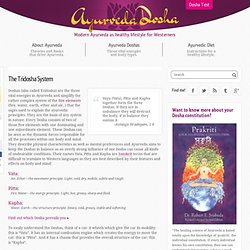

The Latest in Nutrition Related Research. Ayurveda : Home Remedies from Ayurveda for indigestion and chronic indigestion, constipation, common cold, migraines and headaches, insomnia and sleep disorders, stomach pains and stomach aches,... Kapha Dosha - Ayurvedic Diet. Kapha is growth of tissue, production of mucous and fat, and retention of fluids.

Kapha is the stable, relaxed dosha. Kapha is the force of consolidation, solidity and denseness. Kapha people are great homemakers. Kapha is water and earth element. Kapha is white in color. Spinach and Yoga. Keys To A Balanced Ayurvedic Diet: Interview With Lissa Coffey A lot of my clients and friends find Ayurveda very intuitive once they start studying it.

However, applying it to daily life, especially cooking and eating can be a bit overwhelming at first. Don’t worry, it gets much easier with time! Ayurvedic Protocol For Days When You Feel Sluggish and Tired There are days, especially in the Spring when you can barely wake up, feel sluggish and puffy, stomach looks bloated and expanded, and your mind is foggy. An Ayurvedic Blog: Your Modern Guide to Living Healthy Through Ayurveda.
Three Gunas in Ayurveda Diet. 16EmailShare The 3 Grades “Gunas” in the Ayurvedic Diet Ayurveda recognizes more qualities in food than the typical Western system of nutritional values.

In Ayurveda food is classified by these main attributes: All of these attributes are interconnected and influenced by each other but to get a better understanding of the theories, we’ll be looking at the 3 Gunas only here. Rasa: The Six Tastes of Ayurveda help you balance your diet. 102EmailShare The 6 tastes in the Ayurvedic Diet Ayurveda recognizes more qualities in food than the typical Western categorization.

In Ayurveda food is classified by these main attributes: All of these attributes are interconnected and influenced by each other but to get a better understanding of the theories, we’ll be looking at the 6 flavors only here. Ayurveda has a unique approach to break down tastes scientifically, each having its own therapeutic effects and changing impacts on your body; from the first taste to entering the body to being absorbed. Overview. Getting started with Ayurvedic Diet. 12EmailShare Getting started with Ayurvedic Diet in 6 easy steps According to Ayurveda (What is Ayurveda?)

An inappropriate diet can possibly be the reason of many widespread ailments. Modifying your eating habits to suit your person and help your digestion will help your general well-being immensely including the ability to cope better with whatever hurdles your everyday life might put in your way. And while learning Ayurveda usually seems an daunting task the good thing is that you don’t have to learn all about Ayurveda or spend all your money for courses; even a little bit helps to get further. Ayurveda recommends doing all changes gradually and never force yourself to anything. The following list is only a recommendation that many people find easy and natural to follow; it may serve you as an orientation if you’re feeling overwhelmed by all those Ayurvedic principles.
Clean up Have a closer look at your ingredients and try getting less chemicals, preservatives, artificial colors. Ayurveda Vata Dosha: always on the move. The Vata Dosha The Vata Dosha combines the air and ether elements and pictures the movement principle.

Thus it is responsible for all motion related processes in the body; from the blood circulating through your veins to breathing, digestion and nerve impulses running from the brain. Furthermore it is the catalyst for all functions in the body: without Vata’s envolvment Pitta and Kapha couldn’t work either. How to balance the Pitta Dosha. How to balance the Pitta Dosha Ayurveda suggests the principle of opposites to keep a balance between all energies.

Since the primary features of Pitta are lightness, heat, oiliness, sharpness simply spoken everything that is heavy, cold, dry or mild might help to balance an aggravated Pitta Dosha—not only in primary Pitta types, but in every case of an unbalanced Pitta Dosha. Main remedies for too much Pitta: Cooling down your body with cool showers or a bathBitter tastes in your food, also good are sweet and astringent and have it light, fresh or raw and cool.
(Salad is perfect but stay away from heavy, oily dressings)sweet scents and meditation or at least a really quiet surrounding and any low-action activity General Guidelines to balance an aggravated Pitta Dosha: Try to stay cool in every regard: avoid heat or exercising during the hot hours of the day and try not to get around situation that make your blood boil. Ayurveda Kapha Dosha: the gentle and steady body type. Ayurveda Pitta Dosha: fiery energy bombs. The Pitta Dosha The Pitta Dosha combines the fire with the water element and stands for the energy principle.

The primary function of Pitta is transformation, e.g. regulating the body heat through transformation of food to energy, controlling enzymes and even neurotransmitters. AyurvedaDosha. Vayu (Vata), Pitta and Kapha together form the three Doshas.

If they are in unbalance they will destruct the body; if in balance they sustain it. –Astanga Hradayam, 1:6 Doshas (also called Tridosha) are the three vital energies in Ayurveda and simplify the rather complex system of the five elements (fire, water, earth, ether and air, ) that the sages used to explain the ayurvedic principles. They are the basis of any system in nature.